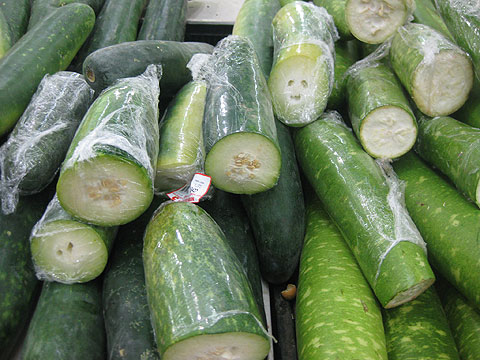Preserving vegetables for weeks with thin film
Mastering some methods of preserving vegetables can help housewives not to go to the market during cold, drizzly winter days while ensuring nutrition for their families.
Preparing a meal with fresh vegetables and tubers also becomes more difficult and difficult. But if using a number of technologies to preserve vegetables simply, save costs, just go to the market once but still have fresh vegetables for the whole month.
In folklore, there are some traditional methods that are still used to preserve fruits and vegetables, such as burying fruits and vegetables, on damp sand to limit dehydration or liming the stalk cut to the root to avoid invading bacteria. into vegetables, fruits .
However, these measures are only applicable to a few types of fruits, the storage time is not long. Many tubers, when buried in moist sand, sprout. In particular, preserving in these traditional ways does not guarantee nutritional content as well as sensory colors of preserved vegetables, tubers and fruits.

The pumpkin is covered with a preservative film that can last for about two weeks and still retain the nutritional content while not preserved and rot after four days.Photo: Thanh Hung
Currently, the most common preservation method is cold storage. But according to nutrition experts, this way of preserving does not save energy and requires high cost. In addition to cold storage methods, there are many types of vegetables and fruits such as PE (Ethylene), PP (Hydrophobic polypropylene), LDPE (Low degree hydrophobic polypropylene), HDPE (Hight degree hydrophobic olypropylene), BOQ - 15, OTTC , OTR, OTR 4000 .
These membranes are made based on MAP technology (Modified Atmosphere Packaging) capable of extending the shelf life of fruits and vegetables from 15 to 20 days at temperatures from 10 to 20 degrees Celsius, In temperature, it can be stored for 3 to 4 days. "These bags have different thicknesses from 25 to 50 micrometers, have different structures. Therefore, they will have the ability to absorb different gases and water to help regulate the storage environment is stable and restrained. respiratory process of vegetables and fruits, helps vegetables and fruits live longer, less changes in hardness, flavor in preservation ', Dr. Chu Doan Thanh, head of postharvest preservation department, Research Institute and food preservation, said.

Currently, the researchers also learn to develop methods to preserve suitable vegetables, tubers and fruits in Vietnamese conditions.Photo: Thanh Hung
This method can be used to preserve a lot of vegetables, tubers, fruits, especially vegetables, tubers and fruits in the winter such as cabbage, Chinese cabbage, squash, kohlrabi, cauliflower, carrots . MAP method reduces respiratory intensity and physiological and biochemical changes processes of vegetables, prolonging the life time of vegetables longer than usual. This technology also works to prevent water evaporation, change the concentration of oxygen and carbon dioxide in a positive direction, helping to limit the loss of vitamins and minerals of vegetables, fruits and vegetables during storage. Thus, the nutritional content of vegetables, tubers and fruits is guaranteed.
'Using these covers shows a good preservation result. A zucchini fruit that has been cut off if used to preserve the film can still leave it until two weeks later and still be sweet and not be faint. If not using the preservation film, it will only take three to four days to get rotten, 'said Mr. Le Quy, working at Big C supermarket.
In addition, this method is very economical. The cost of preserving 1kg of fruits and vegetables by preserving the membrane is only about 200 VND. 'The types of bags and films for preserving vegetables are very good. Morning glory, vegetables . can be left for 6, 7 days without being wilted, stained or pungent. When boiled in water, it is still very green and very sweet . Just spend 45,000 VND to buy a kilogram of bags and films that can be used for the whole year ' , said Ms. Vu Thi Dao, living at 175 Lane, Cau Giay share.
Although very potential, the application of this method of preserving vegetables in Vietnam is not much. According to Dr. Thanh, Vietnamese scientists have initially researched to apply to specific types of vegetables and fruits in the country.
PE bags have poor air permeability so to improve the quality of preserving fruits and vegetables, perforated techniques must be used. PE 40 means that the membrane has 40 holes with a diameter of 0.1mm / hole.
OTR is a type of plastic film, the structure has a certain air permeability. This structure has the ability to reduce anaerobic respiration, limit the concentration of oxygen contained in the bag.
OTR 2000: Type of bag with air permeability with permeability level of 2000 ml of oxygen in 1 hour / m 2 .
- How to keep fresh vegetables without preservatives
- Fruits and vegetables cannot be stored together
- The powder helps American farmers preserve their long-lasting fruit and vegetables
- Preserving fresh fruits and vegetables like picking
- Scientists seek to create ultra-thin keyboards that absorb light
- Technology keeps the flavor of frozen vegetables
- Super thin film can help the laser eye
- Making cakes, Hue girls accidentally discovered materials that can replace nylon
- Method to increase solar cell performance
- Planting seaweed in Truong Sa
- The TV can be rolled into a pocket
- Video: Mini cabinet growing vegetables without caring
 Green tea cleans teeth better than mouthwash?
Green tea cleans teeth better than mouthwash? Death kiss: This is why you should not let anyone kiss your baby's lips
Death kiss: This is why you should not let anyone kiss your baby's lips What is salmonellosis?
What is salmonellosis? Caution should be exercised when using aloe vera through eating and drinking
Caution should be exercised when using aloe vera through eating and drinking